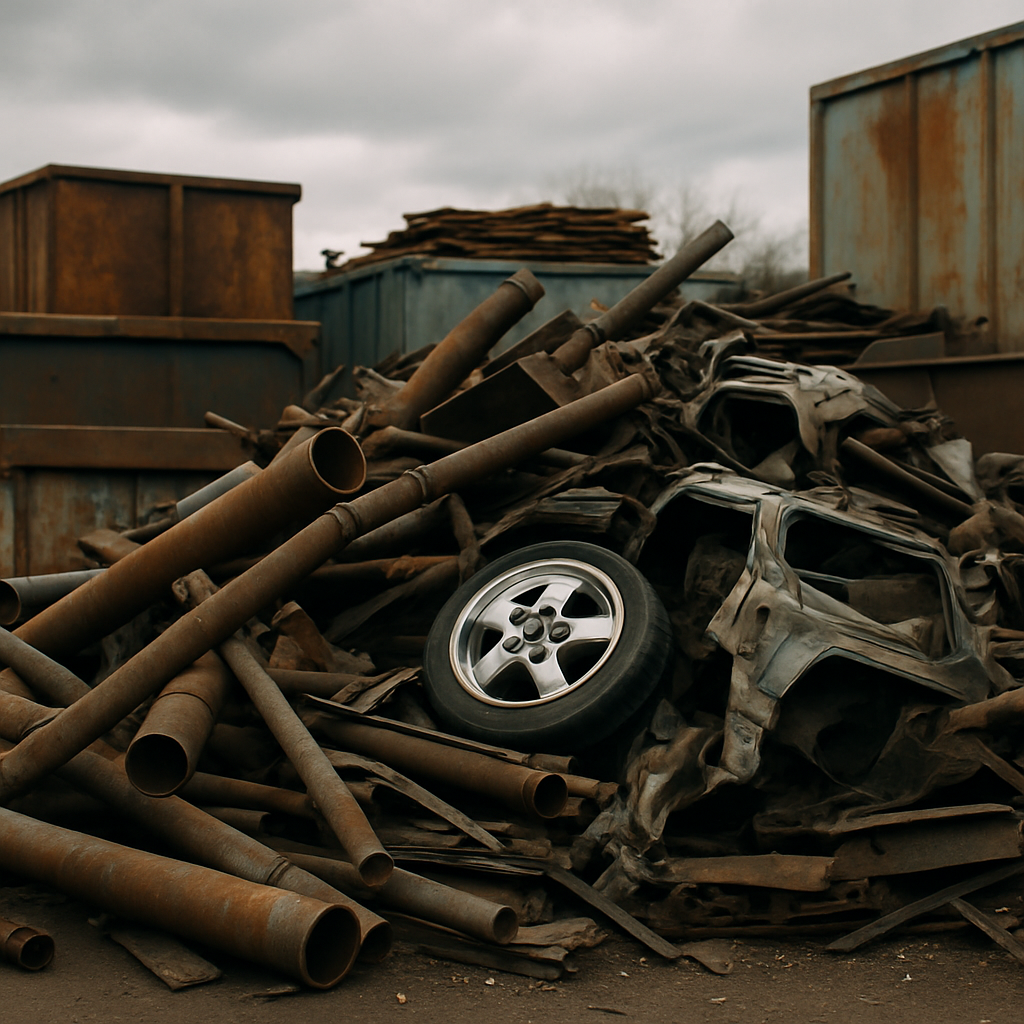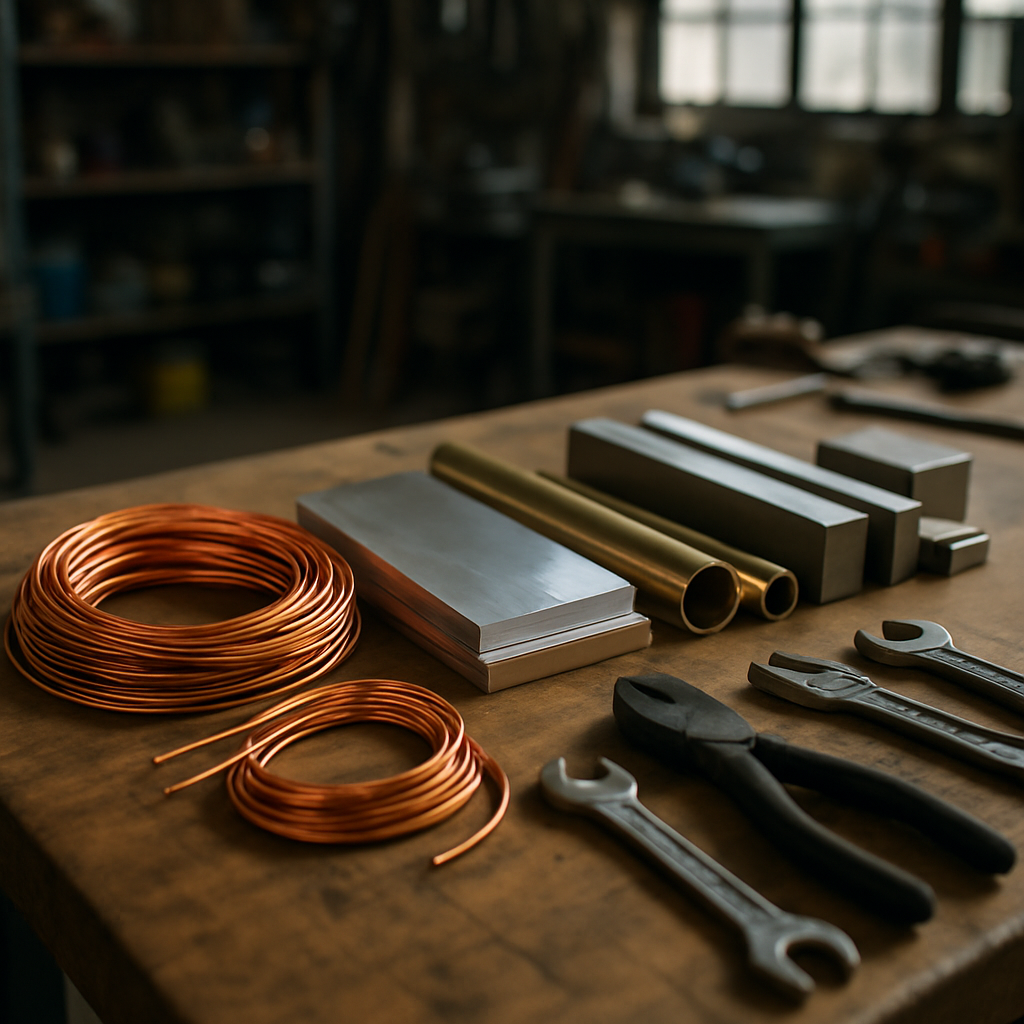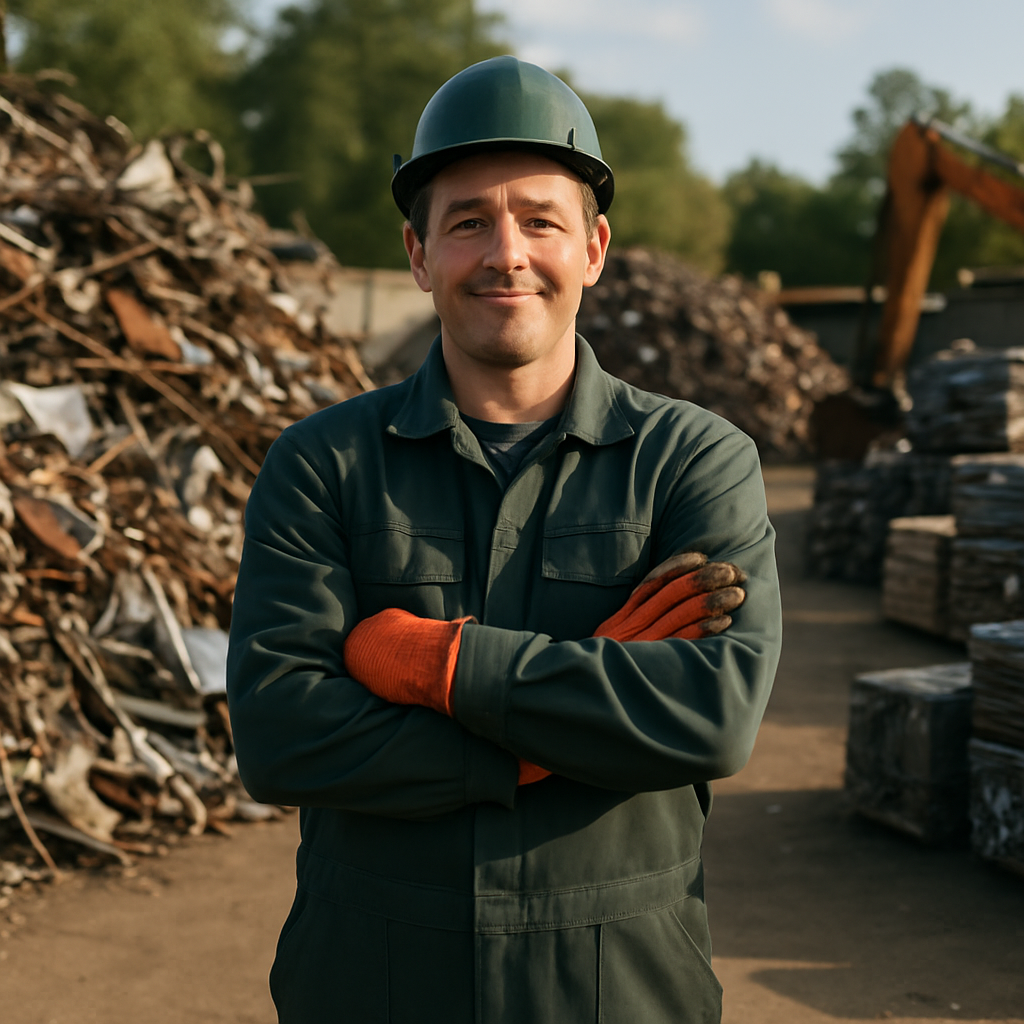5901 Botham Jean Blvd, Dallas, TX 75215
Different Types of Scrap Metals: Ferrous vs Non-Ferrous, Value, and Recycling Tips
September 24, 2025Every piece of discarded metal has value. Whether it’s an old refrigerator, copper pipes from a renovation, or aluminum cans from your recycling bin, knowing what you have is the first step toward responsible recycling and maximizing returns. The scrap metal industry divides these valuable materials into two main categories.
Scrap metals fall into two categories: ferrous and non-ferrous. Ferrous metals contain iron and are magnetic, including steel and cast iron. On the other hand, non-ferrous metals don’t contain iron and are not magnetic, such as aluminum, copper, brass, and lead. Understanding these classifications is crucial for effective recycling and determining the value of scrap metal.
This distinction may seem simple, but it forms the backbone of the scrap metal industry. The magnetic test is the quickest way to determine which category your scrap belongs to. If a magnet sticks to it, you’re holding ferrous metal. If not, you have non-ferrous metal, potentially worth significantly more per pound.
What Are Common Ferrous Scrap Metals?

Ferrous scrap metals contain iron as their primary component, making them distinctly magnetic. Steel and iron comprise most ferrous scrap materials found in both residential and commercial settings. These metals are widely used due to their strength and durability but are prone to rust when exposed to moisture and oxygen.
Steel is the most abundant ferrous scrap metal. It exists in numerous forms, including structural beams, automotive components, and appliance frames. Cast iron, another common ferrous metal, is typically found in older plumbing fixtures, cookware, and engine blocks. Wrought iron, though less common today, appears in decorative railings, gates, and outdoor furniture.
In residential environments, sources of ferrous scrap include steel food cans, appliances like washers and dryers, and obsolete heating systems. Typical household items such as refrigerators, dishwashers, or stoves contain significant amounts of recyclable ferrous metal. Even simple items like steel shelving units or bed frames contribute notably to the ferrous scrap stream.
The automotive industry generates immense quantities of ferrous scrap. Each vehicle contains several hundred pounds of steel in its frame, engine block, and various components. When vehicles reach the end of their useful life, these materials become valuable recyclable resources. Specific automotive ferrous components include drums, rotors, axles, and engine blocks.
Construction and demolition activities produce substantial ferrous waste. Structural steel, rebar, corrugated roofing, and metal studs are all ferrous materials commonly recovered from building projects. Heavy construction equipment and industrial machinery also contribute significantly to the ferrous scrap supply when decommissioned.
Identifying ferrous metals is straightforward with a simple magnet test. If a magnet strongly attaches to the metal, it contains iron and is classified as ferrous. This magnetic property makes ferrous metals easy to separate during recycling processes. For heavily rusted items, cleaning a small area with a wire brush before testing can provide more accurate results.
Despite their abundance and recyclability, ferrous metals typically command lower prices in scrap markets compared to non-ferrous alternatives like copper or aluminum. This price difference stems from their greater availability and simpler recycling processes. Ferrous scrap is generally priced by the ton rather than by the pound.
While ferrous metals may not be as valuable per pound as non-ferrous materials, their recycling remains economically viable due to the large quantities available. Steel is among the most recycled materials globally, with recycled content used in approximately 93% of new steel production for building applications.
Industrial sources of ferrous scrap include manufacturing facilities, shipbuilding operations, and railroad maintenance. These industries generate high-quality ferrous scrap from offcuts, obsolete equipment, and end-of-life products. For example, the shipbuilding industry produces substantial amounts of steel plate scrap during construction and demolition processes.
Recycling ferrous metals significantly reduces environmental impact by decreasing the need for virgin ore extraction. The recycling process for ferrous metals consumes substantially less energy than producing new metal from raw materials, helping to conserve natural resources and reduce carbon emissions.
| Category | Common Items |
| Appliances | Washers, Dryers, Dishwashers, Refrigerators, Freezers, Air Conditioners, Water Heaters, Stoves, Ovens |
| Automobile Parts | Drums, Axles, Rotors, Engine Blocks |
| Cast Iron | Skillets, Tools, Gardening Equipment, Pans, Pots, Sinks, Pipes, Radiators |
| Building Materials | Heating and Air Conditioning Systems, Stairs, Railings, Wire, Containers, Reinforcements, Fittings |
What Are Valuable Non-Ferrous Scrap Metals?

Non-ferrous metals, which do not contain iron, are highly valued in the recycling industry for their exceptional properties. Unlike ferrous metals, they resist corrosion, offer excellent conductivity, and can be recycled repeatedly without losing their valuable properties.
The most valuable non-ferrous scrap metals include copper, aluminum, brass, and lead. These metals command premium prices in recycling markets worldwide, making them particularly attractive for both individual scrappers and commercial recycling operations.
Copper: The King of Non-Ferrous Metals
Copper is the most valuable common non-ferrous metal in the scrap industry. Its reddish-brown color makes it easily identifiable, though it may develop a greenish patina over time. Copper’s excellent electrical conductivity makes it essential in electrical wiring, plumbing fixtures, and electronic components.
Copper scrap comes in different grades, with bare bright copper (uncoated, clean wire) fetching the highest prices. It is commonly found in electrical cables, motors, plumbing pipes, and roofing materials. Separating clean copper from coated or contaminated copper before recycling can significantly increase its value.
Aluminum: Lightweight and Versatile
Aluminum is one of the most abundant and widely recycled non-ferrous metals. Its light weight, corrosion resistance, and malleability make it perfect for applications ranging from beverage cans to aerospace components. Recycling aluminum requires only 5% of the energy needed to produce new aluminum, making it environmentally beneficial.
Common sources of aluminum scrap include beverage cans, window frames, car parts like wheels and engine components, gutters, and electronic devices. While aluminum typically commands lower prices per pound than copper, its abundance makes it a recycling staple.
Brass: Copper-Zinc Alloy with Character
Brass, an alloy primarily composed of copper and zinc, is often recognized by its gold-like appearance. Its excellent acoustic properties, corrosion resistance, and antimicrobial characteristics make it valuable in various applications. Brass commonly appears in plumbing fixtures, musical instruments, decorative items, and door hardware.
The recycling value of brass varies based on its copper content. Red brass, with its higher copper percentage (85-90%), typically commands higher prices than yellow brass (60-70% copper). Brass turnings from machining operations are also widely recycled but may fetch lower prices due to potential contamination.
Lead: Heavy but Valuable
Lead, a dense, bluish-gray non-ferrous metal, is known for its malleability and resistance to corrosion. Despite decreased use in some applications due to toxicity concerns, lead remains valuable in recycling markets. It is commonly found in car batteries, roofing materials, radiation shielding, and some older plumbing systems.
Lead scrap can be highly profitable when recycled, though proper handling is essential due to its toxic nature. Its weight makes transportation challenging, but the high demand often justifies the recycling effort.
Why Non-Ferrous Metals Command Higher Prices
Non-ferrous metals typically fetch higher prices than ferrous metals for several reasons. Their resistance to corrosion makes them more durable and suitable for applications exposed to moisture and weather. Their superior conductivity makes them essential in electrical and thermal applications. Additionally, non-ferrous metals can be recycled indefinitely without degradation, preserving their inherent value.
The recycling market for non-ferrous metals fluctuates based on global demand, industrial needs, and economic factors. Prices are typically set according to standards like the London Metal Exchange, ensuring fair market values for these valuable resources.
Proper sorting and separation maximize the value of non-ferrous metals in recycling. A simple magnet test helps identify non-ferrous metals, as they don’t attract magnets, unlike ferrous counterparts. This straightforward step can significantly increase the return on your recycling efforts.
| Metal | Properties | Applications | Value in Scrap Market |
|---|---|---|---|
| Aluminum | Lightweight, corrosion resistant, good thermal conductivity | Can be used in cans, aerospace components, construction | Lower value compared to copper but highly recycled |
| Copper | High electrical conductivity, corrosion resistant | Used in electrical wiring, plumbing, electronics | High value, especially for clean and bare bright copper |
| Brass | Corrosion resistant, low friction | Plumbing fittings, musical instruments, decorative items | Mid-level value due to component copper content |
| Lead | Dense, malleable, corrosion resistant | Batteries, radiation shielding, some plumbing systems | Variable due to toxicity, but still significant in scrap markets |
How to Sort and Prepare Scrap Metals for Recycling?

Proper sorting of scrap metals is essential for maximizing their recycling value. Well-sorted metals can significantly increase returns—often by 20-40%. A systematic approach not only ensures higher payouts but also contributes to more efficient recycling processes.
Separating Ferrous from Non-Ferrous Metals
The first step in effective scrap metal sorting is distinguishing between ferrous and non-ferrous metals. This basic separation can be easily accomplished with a magnet.
When a magnet sticks to a metal piece, it contains iron and is classified as ferrous. Common ferrous metals include steel, cast iron, and wrought iron. These materials typically fetch lower prices but often make up the bulk of scrap by weight.
Non-ferrous metals don’t contain iron and won’t attract a magnet. These include aluminum, copper, brass, bronze, and lead. Due to their higher value and industrial demand, proper identification and separation of these metals can significantly boost your recycling returns.
Further Categorizing Non-Ferrous Metals
Once you’ve separated your non-magnetic metals, further sort them by type. Each carries different value and recycling potential:
- Copper: Recognized by its reddish-brown color. Consider separating into grades like #1 bare bright copper (clean wire) and #2 copper (painted or with solder).
- Aluminum: Silver in color and notably lightweight. Sort clean extrusions from cast aluminum and beverage cans.
- Brass: Yellow or gold-like appearance, commonly found in plumbing fixtures and decorative items.
- Bronze: Reddish-gold color, slightly darker than brass.
- Stainless Steel: Silver with a distinctive dull finish; some grades may be slightly magnetic.
Preparation Techniques for Maximum Value
Clean metal commands higher prices. Remove contaminants such as dirt, grease, paint, and non-metal attachments. For wiring, stripping copper cables of their insulation can increase their value by 30-50%.
When dealing with complex items like appliances or electronics, dismantle them to separate valuable components. For instance, a washing machine contains a steel outer shell, copper motor windings, and aluminum components that are worth more when separated than recycled as a whole unit.
Organizing Your Sorted Metals
Use dedicated containers for different metal types rather than creating piles. Label each container clearly to maintain separation throughout collection and transport. This prevents mixing and confusion when delivering to recycling centers.
For heavy items, ensure proper lifting techniques and consider the weight capacity of your containers. Some metals, particularly copper and brass, are heavy for their size and require sturdy storage solutions.
| Metal Type | Mixed/Unsorted Price | Properly Sorted Price | Potential Increase |
| Copper | -30% to -50% of optimal | 100% of market value | Up to 50% more |
| Aluminum | -20% to -40% of optimal | 100% of market value | Up to 40% more |
| Brass | -15% to -30% of optimal | 100% of market value | Up to 30% more |
| Stainless Steel | Often missed in mixed scrap | Properly valued | Up to 300% more |
Special Considerations for Electronics and Appliances
Electronic waste contains various valuable metals, including copper, aluminum, gold, and silver. When recycling electronics:
- Remove batteries before recycling as they require special handling
- Separate circuit boards when possible as they may contain precious metals
- Consider consulting specialized e-waste recyclers for items with complex components
For appliances, removing motors, compressors, and wiring before recycling the metal shell can yield better returns. Some recycling centers offer dismantling services for complex items.
Checking Local Requirements
Before transporting your sorted scrap, contact local recycling centers to understand their specific requirements. Some facilities have particular guidelines for preparation, minimum quantities, or restricted materials.
Many recyclers post current prices online or will provide quotes based on photos and weight estimates. This information helps you determine the best timing and location for selling your scrap metal.
By implementing these sorting and preparation techniques, you can maximize the value of your scrap metal while contributing to more efficient recycling processes and resource conservation.
Conclusion: The Importance of Understanding Scrap Metal Types

Understanding the different types of scrap metal is essential for successful recycling. By distinguishing between ferrous and non-ferrous metals using simple techniques like magnet tests, recyclers can sort more effectively and achieve significantly higher returns. Properly identifying copper, aluminum, brass, and steel varieties can increase scrap value by 20-40% compared to unsorted materials.
Proper sorting not only maximizes financial returns but also strengthens environmental conservation efforts. Correctly identifying and separating metals reduces the processing energy required at recycling facilities, creating a more efficient system that conserves natural resources and lessens the need for mining. These environmental benefits also include reduced greenhouse gas emissions and decreased landfill waste.
For all your recycling needs and to maximize the value of your scrap metal, contact Okon Recycling at 214-717-4083. Our team of experts can guide you through the identification process and ensure you receive optimal returns while contributing to a more sustainable future.
